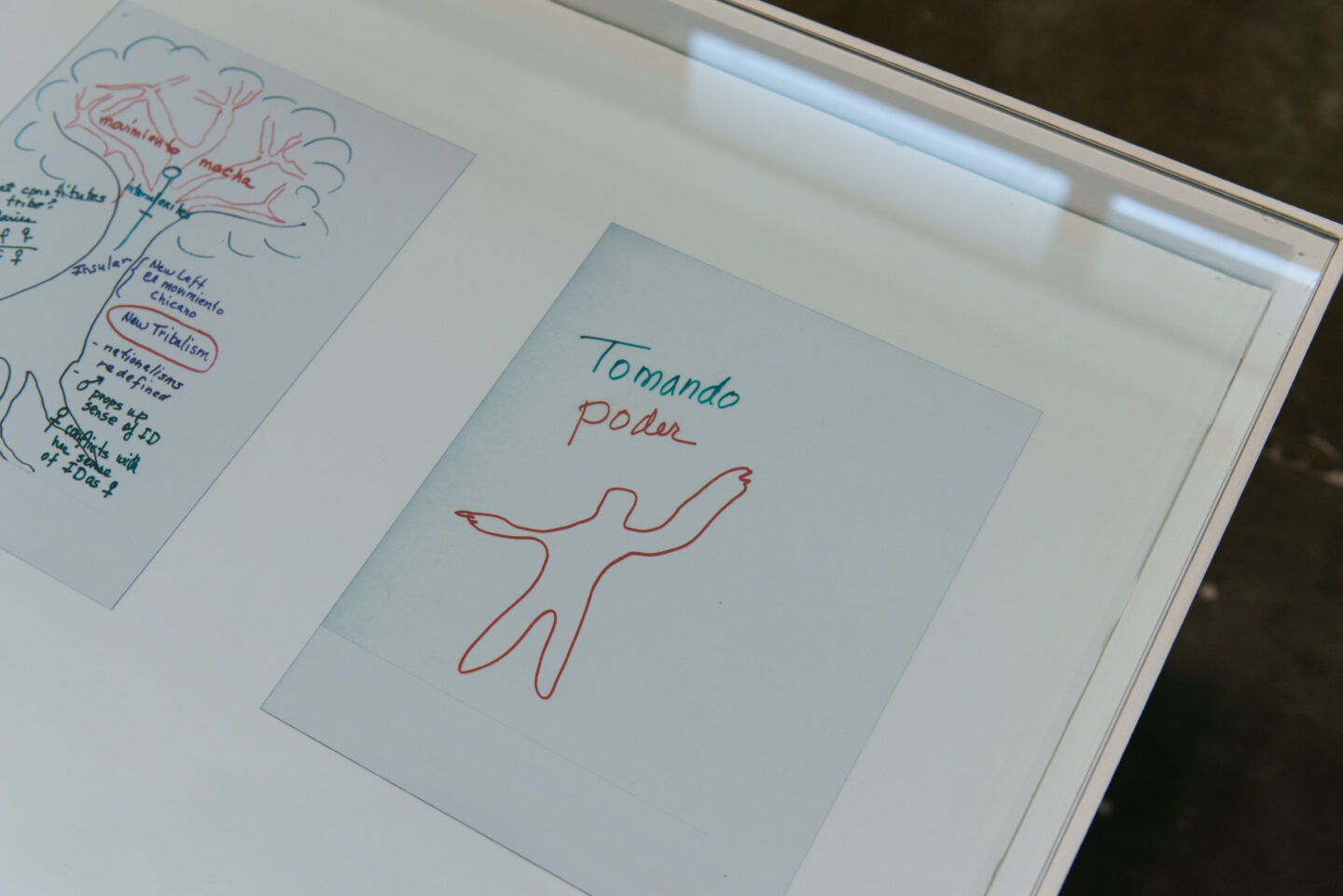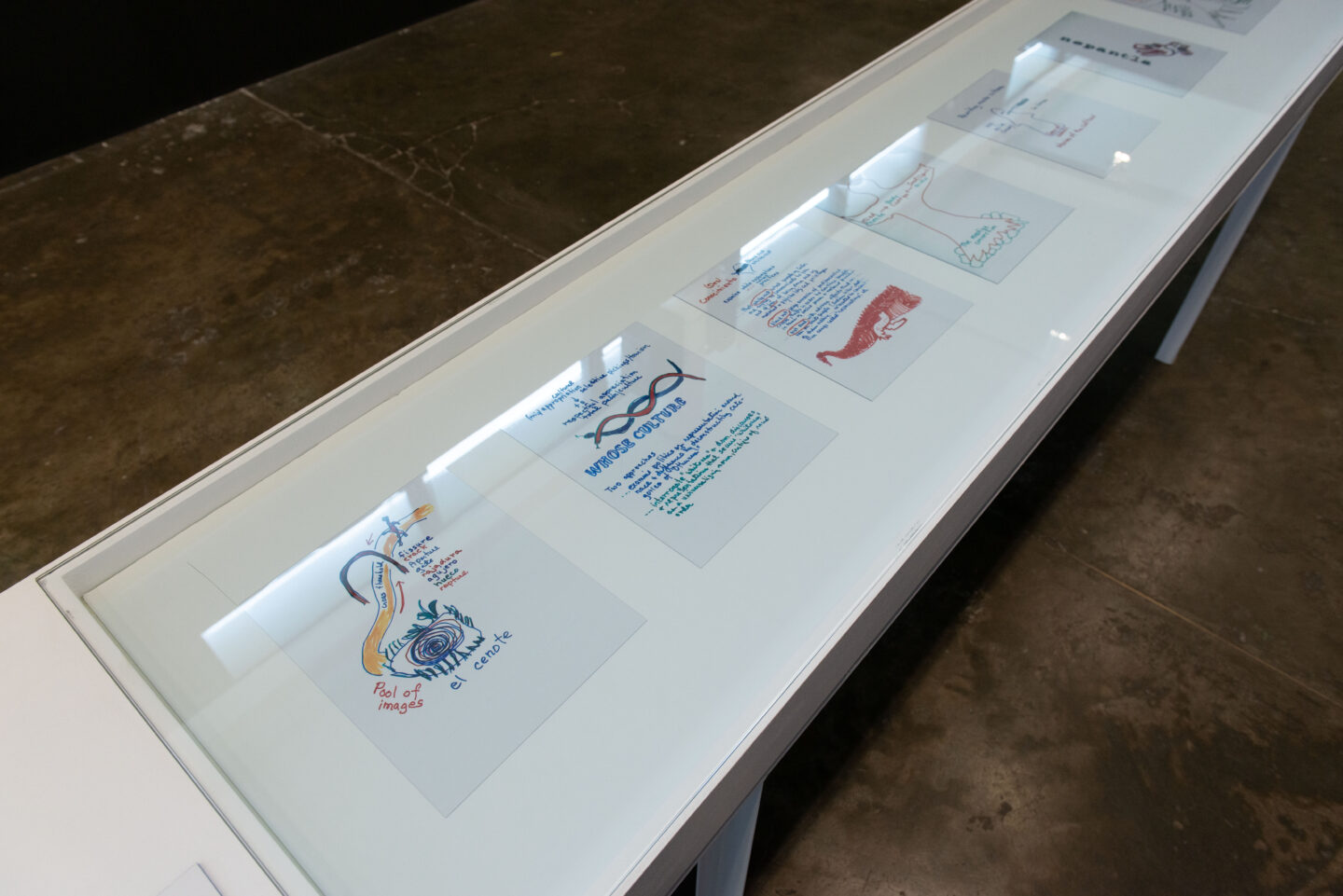
Gloria Anzaldúa
The significance of Gloria Anzaldúa’s work lies in the radical nature of her contributions to critical thinking in decolonial, feminist, and sexuality studies, above all in including geography as a category of social difference. A teacher, writer, and activist, Anzaldúa condemns and questions the violence inflicted on people born in or inhabiting border territories and cultures, especially women “of color”¹ in the third world. Anzaldúa addresses the border that divides the United States and Mexico, now the state of Texas, a strip “bought” by the United States in 1848 through the Guadalupe Hidalgo Treaty. Born in this context, the author portrays the border as a geographical space in dispute and as a metaphor for the societal experiences of the people pressurized every day into choosing a single identity, even when their realities are built on a meeting of cultures.
One of the drawings where Anzaldúa explores her theory in image form, exhibited in the 35th Bienal de São Paulo, portrays a purple, sinuous serpent with a huge mouth biting into an apple. Written in red beneath the drawing is the phrase, “O proibido [The forbidden].” The scene immediately recalls the most famous serpent scene in Western Christian history. However, here the forbidden fruit does not evoke the symbol of Christian repulsion and fear, but rather the most important symbol of pre-Columbian America – a serpent that, to Anzaldúa, is “the symbol of dark sexual impulse, the cthonic (the underworld), the feminine, the sinuous movement of sexuality and creativity, and the basis of all energy and life.”² The idea of putting thought into visual has Mexica origins, the Indigenous culture of Anzaldúa’s ancestry, and an epistemological reference that “did not separate the artistic from the functional, the sacred from the secular, and art from daily life.”³
While writing this text, I saw the news ⁴ that United States immigration officers are told to toss immigrant babies and children found at the border between Texas and Mexico into the river. While policies of surveillance and genocide either create or re-enact ways of maintaining violence and terror, Anzaldúa’s works remain evocative, current, and in action, reminding us that “[…] the war of independence is a constant.”⁵
maria luiza meneses
translated from Portuguese by georgia fleury reynolds
1. See Cherrie Moraga and Gloria Alzandúa, This Bridge Called My Back: Writings by Radical Women of Color (1967), 4. ed. New York: State University of New York Press, 2015.
2. Gloria Alzandúa, Borderlands/La Frontera: La nueva mestiza, translation by Carmen Valle Simón. Madrid: Capitán Swing, 2016, p. 80.
3. Ibid., p. 120.
4. “Agentes da imigração dos eua são orientados a empurrar crianças e bebês em rio na fronteira como México”, O Globo, 20 jul. 2023. Available at: oglobo.globo.com/mundo/noticia/2023/07/20/agentes-da-imigracao-dos-eua-sao-orientados-a- empurrar-criancas-e-bebes-em-rio-na-fronteira-com-o-mexico. ghtml. Accessed: 24 jul. 2023.
5. Anzaldúa, 2016, op. cit., p. 55.
- Detalhe de obra Transparencies for Gigs [Transparências para apresentações], de Gloria Anzaldúa durante a 35ª Bienal de São Paulo – coreografias do impossível © Levi Fanan / Fundação Bienal de São Paulo
- Detalhe de obra Transparencies for Gigs [Transparências para apresentações], de Gloria Anzaldúa durante a 35ª Bienal de São Paulo – coreografias do impossível © Levi Fanan / Fundação Bienal de São Paulo
- Detalhe de obra Transparencies for Gigs [Transparências para apresentações], de Gloria Anzaldúa durante a 35ª Bienal de São Paulo – coreografias do impossível © Levi Fanan / Fundação Bienal de São Paulo
Gloria Anzaldúa (Raymondville, TX, USA, 1942 – Santa Cruz, CA, USA, 2004) was a poet, writer, and feminist theorist. She earned her BA from the University of Texas–Pan American (now University of Texas Rio Grande Valley) and her MA in English from the University of Texas at Austin. Her poems and essays explore the anger and isolation of occupying the margins of culture and collective identity. She is the author of several books of poetry, nonfiction, and children’s fiction. Her book Borderlands/La Frontera: The New Mestiza (1987) and her essay “La Prieta” are considered groundbreaking works in cultural, feminist, and queer theories. With Cherríe Moraga, Anzaldúa co-edited the landmark anthology This Bridge Called My Back: Writings by Radical Women of Color (1981).

 Português
Português

